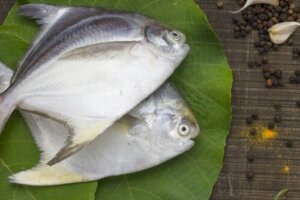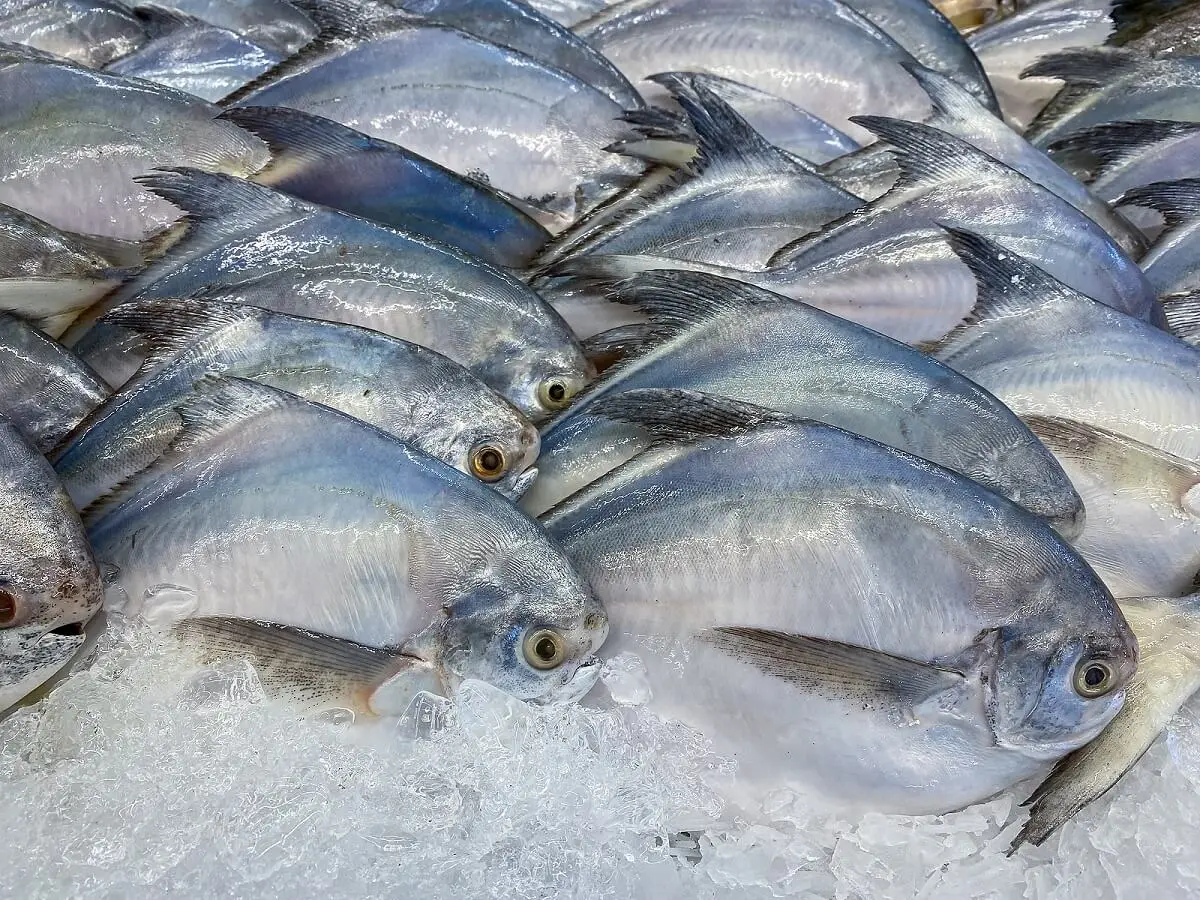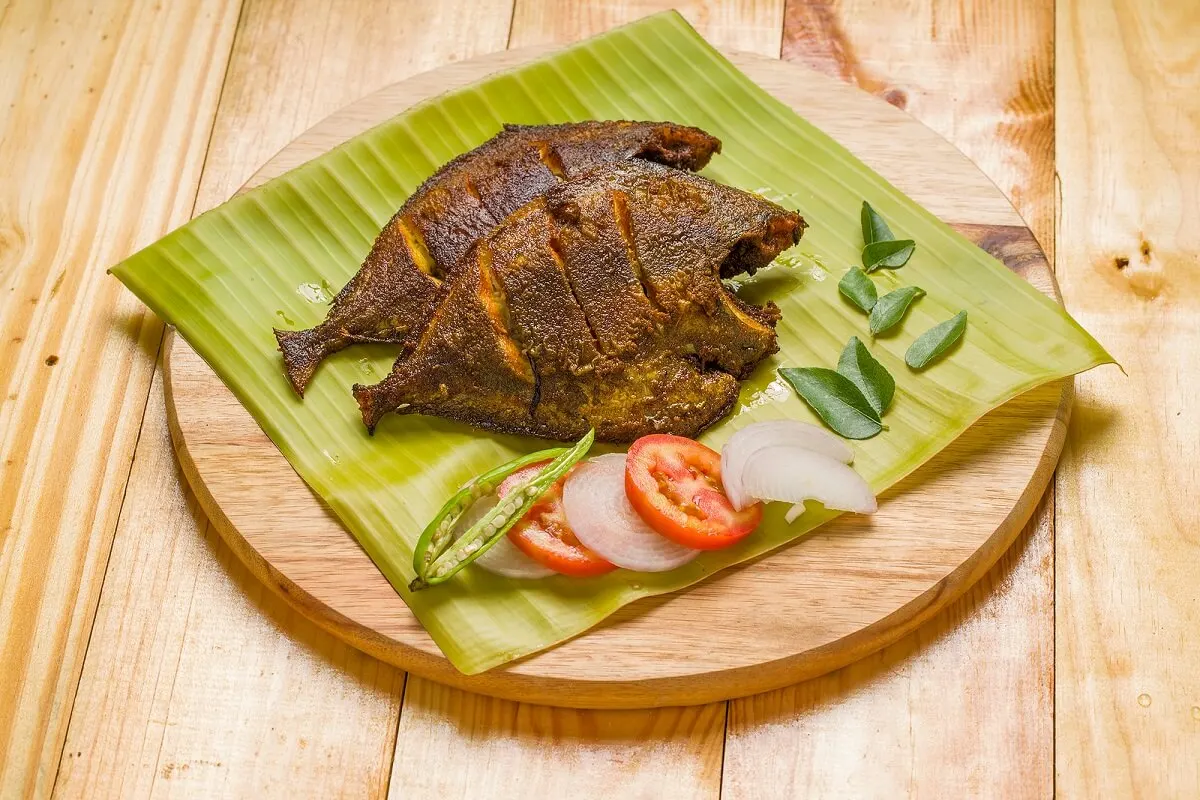Palometa, A Fish That's Abundant in Protein


Written and verified by the nutritionist Maria Patricia Pinero Corredor
Palometa, whose scientific name is Brama brama, is also known as “japuta,” “palometa negra,” “zapatero,” or “castañeta” in Spanish. It’s a common type of fish, since it can be found in practically any sea or ocean. However, few know the truth about this fish.
It turns out that next to bonito, anchovy, salmon, tuna, and sardines, this is one of the types of fish with the most protein. We’ll tell you more about its characteristics and how to include it in your diet to take advantage of its many benefits.
What is Palometa?
The permit is a sea fish that is usually 40 centimeters long, with a flattened and flattened body and a bluish-silver color. It belongs to the family of the bramidae, and there are different varieties, among which the black Palometa stands out.
It stands out for its interesting contribution of proteins, micronutrients, and fat. In fact, it’s actually considered a fatty fish, as every 100 grams provides up to 5 grams of fat. Let’s see more about its nutritional value.

We think you may also enjoy reading this article: Fish Protein: Why It Shouldn’t Be Missing from Your Diet
Nutritional value of Palometa fish
In addition to protein and fat, Palometa provides an interesting contribution of micronutrients. According to information shared by the Spanish Nutrition Foundation (FEN), every 100 grams of this food provides the following:
- Calories: 125
- Protein: 20 grams
- Total fat: 5 grams
- Carbohydrates: 0 grams
- Calcium: 25 milligrams
- Selenium: 45 micrograms
- Phosphorus: 250 milligrams
- Iodine: 48 micrograms
- Sodium: 110 milligrams
- Magnesium: 28 milligrams
- Vitamin B12: 10 micrograms
- Vitamin D: 16 micrograms
- Niacin: 9 micrograms
- Vitamin A: 36 micrograms
Abundant protein in quality and quantity
Most of the nitrogenous substances in fish are forming part of the proteins. Compared to other fish, Palometa has a very good proportion of this powerful nutrient. Let’s take a look at some comparisons:
- Bonito – 24, 7 grams of protein
- Tuna – 21, 5 grams of protein
- Anchovy – 21, 5 grams of protein
- Sardines – 21, 5 grams of protein
- Salmon – 20, 7 grams of protein
- Palometa – 20 grams of protein
As can be seen, the average protein value of Palometa is close to that of other fish such as tuna, anchovy, anchovy, and salmon. Consuming a portion of 200 grams, provides about 40 grams, although that’s without considering the type of cooking.
For example, grilling or baking concentrates protein. In this way, it’s possible to consume a little more than what the raw Palometa provides. Thus, of the 56 grams per day that an adult needs to ingest, Palometa provides three-quarters. For this reason, it’s considered a type of fish that’s abundant in protein.
But what are the types of proteins in the permit and the quality of these nitrogenous substances? Read on to learn them!
Type of protein in Palometa
The muscle of Palometa and that of other fish is characterized by having less connective tissue than the rest of the meats. In addition, it has less elastin than collagen. Because of this, the muscle fibers separate easily and have greater tenderness.
Even so, the low protein content of the connective tissue makes it less resistant to alteration, both enzymatic and bacterial.
From a percentage point of view, 70 to 80% of all proteins are represented by myofibrillar proteins, such as myosin, tropomyosin, and actomyosin, which form short filaments called “myotomes.”
25 to 30% of the protein corresponds to albumin, globulin, and enzymes. These are responsible for the formation of the crust and the browning of the Palometa when baked. They’re also responsible for the presence of foam when boiled.
High-quality protein
It has been highlighted in studies that fish protein is of high quality. In addition, it’s easily assimilated and digestible. However, let’s explain why better.
The links that form the proteins are the amino acids, and for a protein to be considered complete, it must contain 20 in total. Of these, 8 are essential and must be consumed with food, since the body doesn’t produce them. The other 12 are manufactured by the body itself.
Palometa has enough essential amino acids, especially lysine and methionine. Others such as histidine, tryptophan, leucine, isoleucine, threonine, and valine complement its high biological value. For this reason, it has a special place in a healthy diet.
Its contents are similar to those of milk and higher than those of red meat. They mostly exceed the guideline recommended by the Food and Agriculture Organization of the United Nations (FAO).
By consuming about 200 0 300 grams of Palometa, your daily needs of a good part of the essential amino acids are covered, but only 80% of the tryptophan.
Like this article? You may also like to read: 9 Kinds of Unhealthy Fish That Are Better to Avoid
Other nutritional benefits of Palometa fish
In addition to the protein value, Palometa contains other nutrients that cannot go unnoticed and that complement the protein abundance of its meat. Let’s take a look at them.
Fat
It should be noted that the amount of fat that Palometa provides will depend on the species. For example, a species of Palometa known as “white Palometa” (Trachinotus ovatus) is catalogued as a lean fish, since it has no fat. The same is true for the red Palometa.
However, the black Palometa has a higher fat content. For this reason, many classify it as a semi-fatty fish. Depending on these variations, the omega-3 content may also vary in each species.
In addition, it will also depend on the stage of the biological cycle in which it is found. To be considered an oily fish, it must accumulate at least 5% fat at some point in its life.
Fish fat has been found in studies to have benefits on the immune, cardiac, and nervous systems. In addition, it has a positive impact during gestation and fetal growth because it helps with the formation of brain tissue.
Micronutrients
In addition to calcium, phosphorus, potassium, and magnesium, permit provides iodine and selenium. Selenium is a mineral that the body needs for reproductive function and DNA production. There are 45 micrograms in 100 grams of permit. That is to say, if a larger portion is eaten, the necessary daily quota of this mineral is covered.
Iodine is involved in the production of thyroid hormones, responsible for regulating metabolism and other important body functions. Every 100 grams of this fish covers 30% of the daily requirements.
As for vitamins, Palometa is a good source of vitamins B12 and D. The body requires 2.4 micrograms of vitamin B12 per day, and 100 grams of Palometa provide 10 micrograms. Meanwhile, 15 micrograms of vitamin D per day is suggested, and this fish provides 16.
How to prepare Palometa
Palometa can be prepared in many ways; baked, fried, in sauces, steamed, and even grilled. However, one of the healthiest ways is to bake it in the oven.
Ingredients
- 500 grams of Palometa
- 1 lemon
- Salt to taste
Preparation
- Start by washing, scaling, and gutting the fish, removing the guts. Then, let it sit in a bowl with lemon and salt to taste for 30 minutes.
- Bake in the oven at a temperature of 300 or 350 degrees Celsius for 25 minutes.
- Finally, serve it hot, accompanied by plantain, yucca, rice, and lemon (to taste).

How much Palometa can you eat?
Palometa, like other fish, is abundant in protein. Therefore, it can help you to gain muscle mass and the formation of tissue structures in the body. That said, it’s a food that can be included on a regular basis as part of a balanced and healthy diet.
Three to four servings maximum per week are recommended, alternating with white fish that contain less fat. Each serving is the equivalent of 200 grams. If you feel like consuming it daily while varying the type of preparation, you can do it without any problem.
All cited sources were thoroughly reviewed by our team to ensure their quality, reliability, currency, and validity. The bibliography of this article was considered reliable and of academic or scientific accuracy.
- FEN. Palometa. https://www.fen.org.es/MercadoAlimentosFEN/pdfs/palometa.pdf
- OCU. Pescado azul, lo tiene todo. https://www.ocu.org/alimentacion/alimentos/informe/disfruta-pescado-azu
- NIH. Selenio. https://ods.od.nih.gov/factsheets/Selenium-DatosEnEspanol
- NIH. Yodo. https://ods.od.nih.gov/factsheets/Iodine-DatosEnEspanol
- NIH. Vitamina B12. https://ods.od.nih.gov/factsheets/VitaminB12-DatosEnEspanol/
- NIH. Vitamina D. https://ods.od.nih.gov/factsheets/VitaminD-DatosEnEspanol/
- Javier Cañada Millán. Proteína de pescado: nutrición e innovación. Nutr. Hosp. vol.38 spe 2 Madrid 2021 Epub 01-Nov-2021
https://dx.doi.org/10.20960/nh.3795 - María Isabel Castro-González. ÁCIDOS GRASOS OMEGA 3: BENEFICIOS Y FUENTES. INCI v.27 n.3 Caracas mar. 2002. http://ve.scielo.org/scielo.php?script=sci_arttext&pid=S0378-18442002000300005
- Acad Sci U S A. 2006 Mar 28;103(13):4888-93. doi: 10.1073/pnas.0508352103. Epub 2006 Mar 17.
- AVDALOV NATHAN, NELSON. 2014. Beneficios del consumo de pescado
Montevideo: DINARA – INFOPESCA. 30 P
This text is provided for informational purposes only and does not replace consultation with a professional. If in doubt, consult your specialist.








